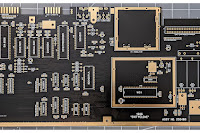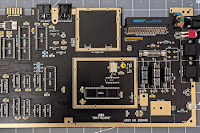Not content with managing to design and have manufactured a perfectly respectable RF Modulator replacement for my SixtyClone 250466 Commodore 64, I had another itch to scratch.
I keep thinking about my "all new" philosophy of these clone boards and whilst I have had to hit the second hand market for a keyboard, CIA chips, the 6510 CPU and the VIC-II there are much smarter enthusiasts than me working hard to resolve this. These are not simple things and it takes a very special range of skills to attempt to replicate these. Skills which I will never, ever achieve. However, buying these parts in the second hand market really does fill me with guilt. I truly don't want a new build to mean an old one has to be butchered.
What I found strange though, is that there is one very particular part that is simply not available new. That part is the humble Cartridge Guide:
 |
| An original Cartridge Guide obtained from Retroleum |
To my, albeit uneducated, eyes, this particular part is simply a stamped and bent piece of metal. By employing highly specialised techniques (ok - I stuck a magnet on it) I've established it is magnetic and it is somewhat flexible. A tour of the internet will reveal pictures of these in all manner of conditions, including rusted, so this evidence suggests these are made from a type of mild steel. It cannot be beyond the wit of our species to have these remanufactured, I thought. However, despite extensive searches on the interwebs, I have drawn a blank. No one is selling them.
So, still on a high from my stunning triumph with my JaF64 RF Modulator replacement I figured I would give this a bash. I mean, how hard could it be, right?
So what would it actually take to construct a new Cartridge Guide?
- Accurate measurements of the original part.
- Some CAD software.
- A manufacturer.
As part of the build process for my SixtyClone, I bought an original cartridge guide but as yet I have not soldered this in to place. Thus it was available to me to measure up.
When I had the PCB for my JaF64 manufactured, I used PCBWay. As well as printing circuit boards it did not escape my attention that PCBWay also offer Sheet Metal fabrication:
Though I must upload a design before I can get a quote so I have zero idea what sort of costs we might be looking at, at these initial stages. And no, this isn't an advert for PCBWay - this is simply the only company I know of that offers the service I need for low volume production. I only require 1 part.
So, of the 3 requirements listed above, we do at least have 2 of these available. All that remains is the CAD software to turn the measurements I need to take, into a file that can be uploaded. That means more Googling.
Now, it will come as no surprise what-so-ever to anyone reading this that I have no experience with CAD software. In the past I've messed about with Bryce and Blender which are more like modelling tools than proper CAD software (maybe I'm doing them a disservice but that's my abiding impression) so I was on the hunt for something which was both free to use, but comprehensive.
As it was, my two requirements (comprehensive, free to use) pretty much narrowed down my search to a single option. FreeCAD. So one substantial download later I was losing myself in the menus and icons of something which was about as far from intuitive as I've ever seen.
Queue hours and hours of YouTube trying to figure out how to get started. I do find (and it was exactly the same when I was designing my PCB) that it really helps to have a specific project in mind when it comes to learning new software as it helps to focus my experimenting and learning, and so it proved here. But I'm getting ahead of myself. Before all of that, the first thing I did was purchase a Digital Vernier Caliper:
And with this, set about the original cartridge guide to get all the necessary measurements. I should say tolerances aren't so tight that we need to be accurate to 100ths of a millimetre so this much cheapness caliper should suffice.
So far so easy. However, when it came to the next stage, using FreeCAD... Well, this is a process I loathed and I confess to hating this software with a passion. It just doesn't seem to be able to do what I need it to do and no matter how much research I do, I've got so far and am now kinda stuck.
Let me explain:
The Cartridge Guide is just a 1mm thick piece of steel with six 90 degree (approx) bends to create the shape we are all familiar with. On each side there are 2 prongs, one of which is an L shape to allow it to "lock" into the main PCB. Curious to the design are 4 embossed "ribs" (for want of a better word), stamped into the steel: one on each side and two on the top. These "ribs" - probably more accurately referred to as "beads" - were (it seemed to me) the whole point of the Cartridge Guide: they protrude into the space around the Cartridge Connector on the main PCB just enough so that ham-fisted attempts to insert a cartridge would be "guided" into the correct position by physically preventing you from moving the cartridge too far out of position, whilst still providing "wiggle room" to allow for easy insertion/extraction. Wiggle room you would not have if the whole guide was simply smaller and a tighter fit. The more I think about it, the more I realise just how smart this design this is.
 |
| Underside of Guide showing bends, solder legs and embossed ribs |
The image below gives an indication of the tolerances available around an original Commodore 64 cartridge within the Cartridge Guide, mounted on my SixtyClone 250466 PCB:
 |
| View of an original Cartridge Guide surrounding a cartridge |
Getting the calipers around the guide revealed the beads only protrude about a millimetre into this space leaving about 1.5mm between the edge of a cartridge and the guide on the horizontal and about 3mm between the top of a cartridge and the guide on the vertical. The beads can't possibly be there for strengthening the steel as they're in the wrong direction for that so the only possible reason for their existence is to help guide the cartridge into the socket. As such they should be replicated.
With FreeCAD I was, with relative ease, able to design the flat shape of the cartridge guide and the solder legs. Here's a much zoomed in screenshot of the right L shaped solder leg for example:
What I couldn't do in FreeCAD, at least natively (and I find this jaw dropping) was bend my flat shape.
After some more Googling and YouTube watching I discovered a plugin called "Sheet Metal" which was able to bend my shape, but in a way I did not expect - if I want to put a right angle in a flat design with a length of 50mm, and the radius of the bend I insert is 1mm - the new bend adds 2mm to my overall length (1mm on the horizontal and 1mm on the vertical) which has the effect of making the design both too tall and too wide. Sigh.
Anyway, after fighting with all this for a while I was able to create the basic design I was looking for but honestly, it was way harder than it really needed to be.
 |
| FreeCAD's 3D View of the correctly shaped Cartridge Guide |
And yes, whilst there's still some work to do to refine the shape of the L shaped prongs, this is still, in essence, what we are looking for. But can you see what it doesn't have?
That's right, there's no beads. And these aren't there because FreeCAD can't do it (at least not in any way I can fathom). I'm clearly under a misapprehension here: isn't sheet metal design a really basic element of CAD? Isn't beading and bending steel a critical element of any sheet metal design? How is it possible that this CAD software either can't do it or obfuscates the process so much that it's not recorded anywhere I can find? Obviously this is my ignorance but honestly, it's been an annoying and frustrating chore.
So, this is as far as I've been able to get. Without the beads it would be a poor replica so there is no point in trying to have anything manufactured. But to satisfy my curiosity, I can export a .step file of what I do have and upload that to PCBWay to get a preliminary quote on what it would cost if I were able to finish the design...
Holy shit. $48. For one part. That includes a black powder-coat, but does not include shipping. And as you can see, that is a pre-quote - the official quote can only be obtained after an engineer review, and let's face it, that price isn't going down, is it? There is also no guarantee PCBWay could, in fact, stamp the part with the ribs, even if I was able to build them into the design - that would require a bespoke die which would probably be extortionate.
I think it's now obvious why this hasn't been done before. Nobody in their right mind is going to pay the best part of $50 (not including shipping which at a guess would be around $30) for a new part when there is plenty of salvage available for a couple of pounds: retroleum, for example sells them for £2.50 (when in stock).
So this particular hair brained scheme is on hold for the foreseeable (probably permanently to be fair). Don't get me wrong - I would absolutely be dumb enough to pay that money, once, to get a bespoke part for my SixtyClone, but until the design is fully resolved, if at all, my bank balance is safe. I can say I tried, but with my limited skills it doesn't seem feasible, or even remotely cost effective.







